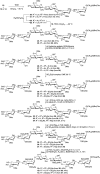The 3- O-sulfation of heparan sulfate modulates protein binding and lyase degradation
- PMID: 33441484
- PMCID: PMC7826381
- DOI: 10.1073/pnas.2012935118
The 3- O-sulfation of heparan sulfate modulates protein binding and lyase degradation
Abstract
Humans express seven heparan sulfate (HS) 3-O-sulfotransferases that differ in substrate specificity and tissue expression. Although genetic studies have indicated that 3-O-sulfated HS modulates many biological processes, ligand requirements for proteins engaging with HS modified by 3-O-sulfate (3-OS) have been difficult to determine. In particular, the context in which the 3-OS group needs to be presented for binding is largely unknown. We describe herein a modular synthetic approach that can provide structurally diverse HS oligosaccharides with and without 3-OS. The methodology was employed to prepare 27 hexasaccharides that were printed as a glycan microarray to examine ligand requirements of a wide range of HS-binding proteins. The binding selectivity of antithrombin-III (AT-III) compared well with anti-Factor Xa activity supporting robustness of the array technology. Many of the other examined HS-binding proteins required an IdoA2S-GlcNS3S6S sequon for binding but exhibited variable dependence for the 2-OS and 6-OS moieties, and a GlcA or IdoA2S residue neighboring the central GlcNS3S. The HS oligosaccharides were also examined as inhibitors of cell entry by herpes simplex virus type 1, which, surprisingly, showed a lack of dependence of 3-OS, indicating that, instead of glycoprotein D (gD), they competitively bind to gB and gC. The compounds were also used to examine substrate specificities of heparin lyases, which are enzymes used for depolymerization of HS/heparin for sequence determination and production of therapeutic heparins. It was found that cleavage by lyase II is influenced by 3-OS, while digestion by lyase I is only affected by 2-OS. Lyase III exhibited sensitivity to both 3-OS and 2-OS.
Keywords: 3-O-sulfation; anti-Factor Xa; glycan microarray; heparin lyases; herpes simplex virus 1.
Conflict of interest statement
The authors declare no competing interest.
Figures









Similar articles
-
Discovery of a heparan sulfate 3-O-sulfation specific peeling reaction.Anal Chem. 2015 Jan 6;87(1):592-600. doi: 10.1021/ac503248k. Epub 2014 Dec 22. Anal Chem. 2015. PMID: 25486437 Free PMC article.
-
Overexpression of heparan sulfate 6-O-sulfotransferases in human embryonic kidney 293 cells results in increased N-acetylglucosaminyl 6-O-sulfation.J Biol Chem. 2006 Mar 3;281(9):5348-56. doi: 10.1074/jbc.M509584200. Epub 2005 Dec 2. J Biol Chem. 2006. PMID: 16326709
-
Relative susceptibilities of the glucosamine-glucuronic acid and N-acetylglucosamine-glucuronic acid linkages to heparin lyase III.Biochemistry. 2004 Jul 6;43(26):8590-9. doi: 10.1021/bi036250k. Biochemistry. 2004. PMID: 15222770
-
Heparan sulfate 3-O-sulfation: a rare modification in search of a function.Matrix Biol. 2014 Apr;35:60-72. doi: 10.1016/j.matbio.2013.12.001. Epub 2013 Dec 19. Matrix Biol. 2014. PMID: 24361527 Free PMC article. Review.
-
The "in and out" of glucosamine 6-O-sulfation: the 6th sense of heparan sulfate.Glycoconj J. 2017 Jun;34(3):285-298. doi: 10.1007/s10719-016-9736-5. Epub 2016 Nov 3. Glycoconj J. 2017. PMID: 27812771 Review.
Cited by
-
CarboGrove: a resource of glycan-binding specificities through analyzed glycan-array datasets from all platforms.Glycobiology. 2022 Jul 13;32(8):679-690. doi: 10.1093/glycob/cwac022. Glycobiology. 2022. PMID: 35352123 Free PMC article.
-
Optimal Extracellular Matrix Niches for Neurogenesis: Identifying Glycosaminoglycan Chain Composition in the Subventricular Neurogenic Zone.Front Neuroanat. 2021 Oct 4;15:764458. doi: 10.3389/fnana.2021.764458. eCollection 2021. Front Neuroanat. 2021. PMID: 34671246 Free PMC article. Review.
-
Emerging chemical and biochemical tools for studying 3-O-sulfated heparan sulfate.Am J Physiol Cell Physiol. 2022 Jun 1;322(6):C1166-C1175. doi: 10.1152/ajpcell.00110.2022. Epub 2022 Apr 13. Am J Physiol Cell Physiol. 2022. PMID: 35417268 Free PMC article. Review.
-
Modeling interactions between Heparan sulfate and proteins based on the Heparan sulfate microarray analysis.Glycobiology. 2024 May 26;34(7):cwae039. doi: 10.1093/glycob/cwae039. Glycobiology. 2024. PMID: 38836441 Free PMC article.
-
Targeting heparan sulfate-protein interactions with oligosaccharides and monoclonal antibodies.Front Mol Biosci. 2023 May 19;10:1194293. doi: 10.3389/fmolb.2023.1194293. eCollection 2023. Front Mol Biosci. 2023. PMID: 37275960 Free PMC article. Review.
References
-
- Esko J. D., Selleck S. B., Order out of chaos: Assembly of ligand binding sites in heparan sulfate. Annu. Rev. Biochem. 71, 435–471 (2002). - PubMed
-
- Bishop J. R., Schuksz M., Esko J. D., Heparan sulphate proteoglycans fine-tune mammalian physiology. Nature 446, 1030–1037 (2007). - PubMed
-
- Sasisekharan R., Venkataraman G., Heparin and heparan sulfate: Biosynthesis, structure and function. Curr. Opin. Chem. Biol. 4, 626–631 (2000). - PubMed
Publication types
MeSH terms
Substances
Grants and funding
LinkOut - more resources
Full Text Sources
Other Literature Sources
Miscellaneous

